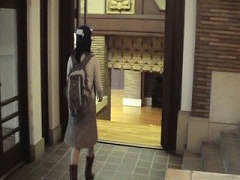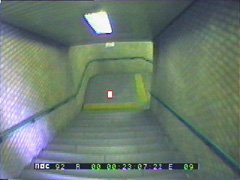Toshitomo Suzuki and Shigeyuki Okazaki,
Visual Search while Climbing or Descending the Staricases at a Subway StationJournal of Architecture, Planning and Environmental Engineering (Transaction of AIJ), No.558, pp.151-158, 2002.8Experiments were conducted concerning fixation movements while climbing or descending the staircases at a subway station. In climbing or descending, fixation movements differed, but tended to occur near the stairs and at occluding edges of floor or walls, and were greatly changed depending on if they were visible or not. When climbing the staircases, fixation also changed depending on where the subject was located at the stairs, whether making a turn or walking straight at landing. Fixation movements on the occluding edge, blocking off the turn following immediately after the stairs, inform us the danger that exists.
Toshitomo Suzuki, Shigeyuki Okazaki, Yi-Chen Wu and Tatsuya Ueno, Experiments Using an Eye-camera to Observe Human's Eye-fixation Movements while Climbing or Descending the Staircases at a Subway Station- Research on the Eye-fixation while Climbing or Descending at Staircases, Part 1 -Summaries of Technical Papers of Annual Meeting Architectural Institute of Japan, E-1, pp.743-744, 2001.9To understand how humans receive information from the surrounding environment while walking, experiments were done on way-finding, recorded by an eye-camera, in a small maze and subway stations. In this study, experiments are conducted in finding out the fixation movements while ascending or descending the staircases at a subway station. Fixation behavior are put in the following four categories: slanting fixation beyond the occluding edge, fixation on the point of ascending or descending at stairs, corner fixation, and fixation on the surface of the wall, floor, ceiling, or stairs. PDF(in Japanese, 133KB)
Characteristics of Eye-fixation Movements while Climbing the Staircases- Research on the Eye-fixation while Climbing or Descending at Staircases, Part 2 -Summaries of Technical Papers of Annual Meeting Architectural Institute of Japan, E-1, pp.745-746, 2001.9The characteristics of one's fixation movements while climbing the staircase are being studied. Different situations are taken into consideration, such as whether the subject is ascending the stairs or if he is at the landing of the staircase, if he was able to see the landing at the top of the staircase, and if he sees the occluding edge of the wall or not. Fixation movement changes depending on where the subject is located. While the subject approaches the staircase, fixation occurs at different locations, depending on if he was making a turn or walking straight. PDF(in Japanese, 249KB)
Characteristics of Eye-fixation Movements while Descending the Staircases- Research on the Eye-fixation while Climbing or Descending at Staircases, Part 3 -Summaries of Technical Papers of Annual Meeting Architectural Institute of Japan, E-1, pp.747-748, 2001.9The characteristics of one's fixation movements while descending the staircase are being studied. In the case that the stairs is not hidden behind an occluding edge, fixation points tend to occur near where the staircase is. When the stairs and the occluding edge of either the floor or the ceiling, or both, are visible, the fixation movement tends to be going back and forth in the vertical direction. In the situation that the staircase is hidden by an occluding edge, fixation occurs at the occluding edge. PDF(in Japanese, 226KB)
|

|
|
Toshitomo Suzuki and Shigeyuki Okazaki, Characteristics of Visual Search and Pedestrian Movement in Koshien Kaikan (the former Koshien Hotel)Summaries of Technical Papers of Annual Meeting, Architectural Institute of Japan, E-1, pp.937-938, 2007.8PDF(in Japanese, 593KB)
Toshitomo Suzuki, Mai Uemura, Maiko Hirano, and Shigeyuki Okazaki, Comparison of Visual Search while Ascending and Descending three Types of StaircasesTechnical Report of IEICE, Vol.108, No.182, HIP2008-35, pp.25-30, 2008.8Experiments were conducted, with subjects wearing eye cameras, on the ascent and descent of three types of indoor staircases; 90-degree change staircase, straight-flight staircase, and dog-legged staircase. Each experiment was conducted on a university grounds using subjects who were familiar with the campus. Similarities and differences were found between the data collected on the visual search of the subjects while ascending and descending the three types of staircase. Results were also compared with past experimental data obtained from the entrances of subway stations. As a result, visual search in staircases can be classified into two types: one influenced by decoration, staircaseshape, or path-learning by the subjects; the other where the subject was not influenced by these elements.
Toshitomo Suzuki, Mai Uemura, Maiko Hirano, and Shigeyuki Okazaki, Experiments Using an Eye-camera while Climbing and Descending the three Kinds of Staircases - Visual Search while Climbing or Descending the Staircases in Koshien Kaikan and Architecture Studio, Mukogawa Women's University, Part 1 -Summaries of Technical Papers of Annual Meeting, Architectural Institute of Japan, E-1, pp.573-574, 2008.9PDF(in Japanese, 601KB)
Maiko Hirano, Mai Uemura, Toshitomo Suzuki, and Shigeyuki Okazaki, Comparison of Visual Search while Climbing the Staircases- Visual Search while Climbing or Descending the Staircases in Koshien Kaikan and Architecture Studio, Mukogawa Women's University, Part 2 -Summaries of Technical Papers of Annual Meeting, Architectural Institute of Japan, E-1, pp.575-576, 2008.9PDF(in Japanese, 563KB)
Mai Uemura, Toshitomo Suzuki, Maiko Hirano, and Shigeyuki Okazaki, Comparison of Visual Search while Descending the Staircases- Visual Search while Climbing or Descending the Staircases in Koshien Kaikan and Architecture Studio, Mukogawa Women's University, Part 3 -Summaries of Technical Papers of Annual Meeting, Architectural Institute of Japan, E-1, pp.577-578, 2008.9PDF(in Japanese, 592KB)
Toshitomo Suzuki, Mai Uemura, Maiko Hirano, and Shigeyuki Okazaki, Changes of Eye Movement Direction while Ascending or Descending StaircasesTechnical Report of IEICE, Vol.109, No.83, HIP2009-53, pp.27-32, 2009.6We focused on the distributions of eye movement directions as quantification of results from experiments in which subjects wearing eye cameras ascended and descended three types of indoor staircases: a 90-degree-change staircase, a straight-flight staircase, and a dog-legged staircase. It was studied how the distributions varied depending on whether stepping on stairs or a landing, and with variations of scenery ahead. As a result of analysis and discussion, it was found that the eye movement directions on staircases varied greatly depending on several factors: whether ascending or descending, on stairs or landing, blind staircase or not, and turning angle of the pedestrian on the landing or just in front of a staircase.
Toshitomo Suzuki, Mai Uemura, Maiko Hirano, and Shigeyuki Okazaki, Distributions of Visual Search Directions while Climbing and Descending the Staircases - Visual Search while Climbing or Descending the Staircases in Koshien Kaikan and Architecture Studio, Mukogawa Women's University, Part 4 -Summaries of Technical Papers of Annual Meeting, Architectural Institute of Japan, E-1, pp.621-622, 2009.8
|

|



